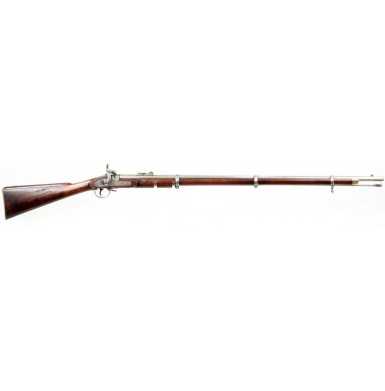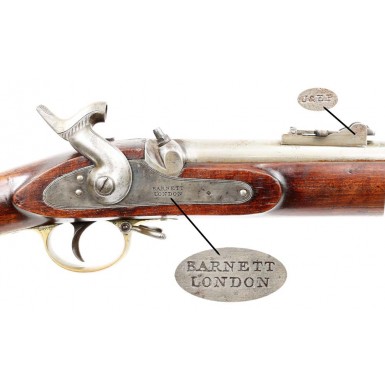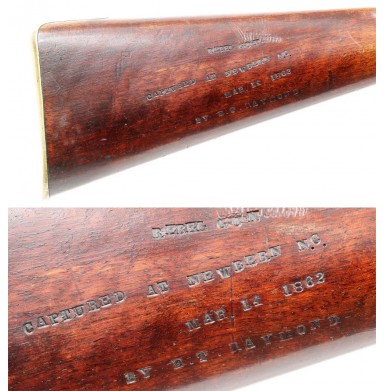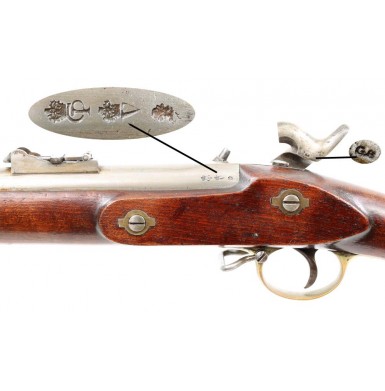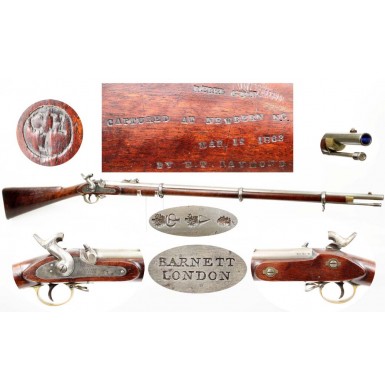Confederate CH-1 Marked Barnett - Captured at New Bern
- Product Code: FLA-3283-SOLD
- Availability: Out Of Stock
-
$1.00
There is no English gun maker who could more appropriately be called the “Gun Maker to the Confederacy” than the London firm of John Edward Barnett & Sons. During the course of the American Civil War, Barnett delivered thousands of P-1853 “Enfield” rifle muskets, as well as P-1853 artillery and P-1856 cavalry carbines to the Confederacy. Barnett also delivered large numbers of obsolete arms like Brunswick rifles and P-1851 Mini” Rifles to Confederate buyers. Barnett not only filled Confederate central government contracts, but also orders for the Confederates states of Georgia, North Carolina, and South Carolina. The Barnett family could trace their gunmaking heritage to Thomas Barnett who operated in London as early as 1796. In 1811 the firm became Thomas Barnett & Sons, and John Edward Barnett subsequently succeeded to the business in 1833. In 1842 the firm was renamed JE Barnett & Sons and operated under that name until 1901 when they became JE Barnett & Sons LTD, going out of business in 1908. During the Civil War years, the Barnetts operated at both their 134 Minories address, which had been established in 1833, and at Brewhouse Lane, Wapping, where they operated from 1860-1874. In the typical fashion of the old time gunmakers in England, Barnett relied heavily on a variety of contractors to produce piecework parts, which were subsequently assembled into complete arms in the Barnett shop. While Barnett could clearly manufacture entire guns in house (and regularly did), it was often more expedient and cost effective to sub-contract for major components when large contracts were received and had to be filled quickly. Many of the orders received from the Confederacy during the course of the American Civil War were just these types of orders, which had to be completed as quickly as possible. It is not uncommon to disassemble a P-1853 rifle musket with a Barnett marked lock, only to discover that the gun may have been assembled by Barnett, but that few (if any of the components) were produced by Barnett. These guns often bear Confederate viewers marks such as the small CH / 1 in circle (the mark of Barnett’s Confederate contract viewers Isaac Curtis & Charles Hughes), or one of the known marks of Sinclair, Hamilton & Company “ a primary supplier of English arms and materiel to the Confederacy. Even those Barnett arms devoid of documented Confederate inspection marks are often Confederate related arms. Barnett delivered a number of guns, presumably to the Confederacy, that were assembled by other makers, but are marked BARNETT / LONDON in the wood; either on the stock flat opposite the lock or along the toe of the stock. These were clearly guns purchased by Barnett to get a nearly finished order “out the door” as expeditiously as possible.
This Barnett P-1853 Enfield is marked with the well documented CH / 1 viewers mark within in a circle on the top of the stock comb. The mark is that of English arms viewers Isaac Curtis and Charles Hughes, who were hired to inspect arms for the Confederacy. The majority of their work appears to have been performed on arms produced or delivered by Barnett. Their mark is found on Barnett marked P-1853 Enfield Rifle Muskets, as well as surplus Pattern 1851 Mini” Rifles and Brunswick Rifles that Barnett delivered to the Confederacy. However, the Confederate related markings on this Barnett P-1853 Enfield do not end there. The obverse buttstock of the gun is marked in four lines with the following information:
REBEL GUN
CAPTURED AT NEW BERN N.C.
MAR 14 1862
BY E.T. RAYMOND
The information is stamped with individual 1/8” tall letters that have serifs in a period appropriate font, similar to today’s “Times New Roman”. Ordinarily such a stamped “identification” would be looked upon with a jaundiced eye, but sufficient provenance accompanies the gun to firmly convince me that the marking is absolutely genuine and of the period, either during or immediately after the war, and that the mark was indeed applied by E.T. Raymond, who acquired the gun in New Bern, NC during 1862.
Edward Tilly Raymond was born in Worcester, Massachusetts on August 8, 1844, the son of Tilly and Mercy Raymond. The 1860 Census noted that Edward was 16 years old and living at home with his father, mother and an 18-year-old man named Nicholas Lewis who was born in Scotland. Lewis was likely an apprentice to Edward’s father, who was listed as a carpenter in the census. Tilly Raymond was clearly a successful carpenter, as the census further noted that he owned real estate valued at $4,500 and had a personal estate valued at $1,400. On October 31 of the following year, at the age of 17, Edward Tilly Raymond enlisted for three years’ service in the 25th Massachusetts Volunteer Infantry, in response to Abraham Lincoln’s call for volunteers to put down the southern rebellion. Young Edward, a student at the time, must have lied about his age as his enrollment papers list him as being 18 years old, but he was only 17 at the time. Ten days later, on September 10, 1861 he was officially mustered into Captain Denny’s Company of the regiment as 2nd Sergeant. Captain Denny’s Company would become Company K of the 25th Massachusetts Volunteer Infantry. The 25th Massachusetts Volunteer Infantry was organized at Camp Lincoln in Worcester, MA under the command of Colonel Edwin M. Upton. The regiment was assigned to Foster’s 1st Brigade of General Ambrose Burnside’s Expeditionary Force. This force was sent to North Carolina in an attempt to capture coastal defenses and ports, which were vital to the Confederate line of supply coming from Great Britain. In January of 1862 the expeditionary force of three brigades departed from Fortress Monroe and proceeded to Hatteras Inlet to combine with US naval forces that would be utilized as part of the campaign. The Federal’s launched their first major assault on Roanoke Island, on February 7-8 of 1862, and the superior Union force quickly overcame the Confederate defenders. The 25th Mass suffered 50 casualties during the battle, including 5 killed outright. Many of the 45 wounded would subsequently dies as well. Burnside followed up this success by attacking New Bern on March 14, 1862. Again, the overwhelming Federal strength quickly subdued the Confederate defenders. In this confrontation the 25th Mass suffered 20 casualties, including 3 dead on the field. Burnside followed up these two successes by attacking Fort Macon on the Outer Banks, which defended the Confederate held ports of Beaufort and Morehead City. The siege, which lasted from March 23 to April 26, 1862, eventually broke the Confederate defenders, and the result was that these ports were closed to any further blockade runner traffic. The 25th Massachusetts remained in New Bern after its capture as part of the garrison force, and remained in the general area, operating as pickets and outpost troops based in New Bern until December of 1863, when the regiment returned to Newport News, Virginia.
On September 5, 1862 Sergeant Edward T. Raymond was discharged from Company K of the 25th Massachusetts Volunteer Infantry, by order of the War Department, to accept a lieutenant’s commission in the 36th Massachusetts Volunteer Infantry. E.T. Raymond returned to Massachusetts and mustered in as a 1st Lieutenant in Captain Bailey’s Company of the 36th Mass. E.T. Raymond remained with Company G of that regiment until January 30 of 1863, when he was promoted to Captain and transferred to command Company C of the regiment. However, in the typical slowness of the army, Raymond’s commission was not “effective” until March 1 of 1863. A March 18, 1863 letter from Raymond to the adjutant general requests a leave of absence of 20 days to recover from “intermittent fever”, which the accompanying surgeon’s certificate indicates might become “debilitating” if Raymond were not granted leave. Raymond took his brief respite, but made another application for 20 days leave on August 20th, 1863 with the surgeon noting not only the “intermittent fever”, but also “chronic diarrhea”. The surgeon noted that Raymond had been suffering from these health issues since July of 1863 and that “in consequence there-of he is in my opinion unfit for duty.” E.T. Raymond is listed as “absent without leave” from Company C from September 9, 1863 to October 31, 1863, but this appears to be a result of his inability to recover from his physical ailments, as an additional surgeon’s letter, dated September 10, 1863 notes that Raymond was “so much debilitated as to be confined to his bed”. An additional surgeon’s letter, testifying to Raymond’s disability was submitted to the Adjutant General as well. It appears that Raymond was subsequently granted at least two short periods of leave in order to allow him to recover, including a 20 day and a 15 day leave of absence. The next record card notes that on November 17, 1863 he was transferred to command of Company I. E.T. Raymond spent the next two to three months on detached duty on the brigade staff, and on April 25, 1864 was transferred to command of Company E, which he assumed on April 27. However, Captain Edward T. Raymond did not remain there long and on July 26, of 1864 he was transferred to Company B of the regiment. By November of 1864, E.T. Raymond had been transferred to the Divisional Staff, serving as the Inspector General of the 2nd Division of the 9th Corps, to which the 36th Mass was assigned from April 1864 through June of 1865. On February 6th 1865 Edward T. Raymond was brevetted to the rank of major for “gallantry and meritorious services during the operations before Richmond, VA.” This corresponds to the dates for the Battle of Hatcher’s Run (February 5-7, 1865). During his time with the 36th Massachusetts Volunteer Infantry, the regiment was heavily engaged in a number of battles in both the Western and Eastern Theater. During his early days with the regiment at the end of 1862, the 36th participated in the battle of Fredericksburg, followed by Ambrose Burnside’s ill-fated “Mud March”. The regiment was then sent from Newport News, VA to Lexington, KY, eventually joining Grant’s forces for the Vicksburg Campaign that culminated with the siege and defeat of that Confederate bastion. The 36th then returned to Kentucky and moved on to Knoxville, where they helped to repulse General Longstreet’s campaign to seize that city. In the spring of 1864 the regiment moved back to Virginia, taking part in the Rapidan Campaign, including the battles of The Wilderness, Spotsylvania and Cold Harbor, and eventually finding themselves before Petersburg, where the 36th participated actively in that siege. The 36th fought at the battles of the Crater, Weldon Railroad, Boydton Plank Road and Hatcher’s Run, among others, as part of the Petersburg Campaign. After the fall of Petersburg, the 36th moved on to Farmville, VA, then to City Point and eventually Alexandria, finally participating in the Grand Review in Washington on May 23, 1865. Brevet Major Edward Tilly Raymond was mustered out of service on June 8, 1865. He returned to Worcester, MA where he married and subsequently had a successful career as a lawyer. He was a member of G.A.R. Post #10 (George H. Ward) in Worcester, as well as a member of the Masonic Lodge. In 1871 his only child, Maud, was born. Major Edward Tilly Raymond of Worcester, MA died on November 9, 1913 at the age of 69.
In most cases, an army in the field has little opportunity to take souvenirs, other than small items of value that are easily transported, as the army is usually moving too fast to be encumbered by plunder. In the case of the 25th Mass, the men of that regiment participated in two fights (Roanoke and New Bern) and then became somewhat static, operating for the remainder of the year in the New Bern area and using New Bern as a base of operations. That gave the men an unusual opportunity to acquire the souvenirs of war that men have collected from time immemorial, as well as the chance to keep them, trade them and even send them home. In the case of Edward T. Raymond, the receipt of his commission as lieutenant in another regiment gave him the opportunity to return home only a few months after the battle of New Bern, and as a newly commissioned officer was likely allowed to bring a small amount of baggage with him. This Enfield rifle musket was likely part of that baggage. Whether Raymond acquired the gun on the day of the battle in New Bern, or more likely in the days after the Confederate surrender, is of no consequence. He obtained a Confederate rifle musket, marked it to make a memento of the events he was a participant in, and took it home to Worcester as a keepsake. The gun was subsequently purchased in 1973 by New York City arms collector named Alan Jay Gaines. Mr. Gaines acquired the gun that year while visiting friends in Holden, MA, just outside of Worcester. He had been looking through an antique store when he asked the owner if they had any old guns. The owner, an older lady, said that her late husband had collected Kentucky rifles, which Mr. Gaines was particularly interested in. However, these were packed away and not immediately available. However, she did have two other guns that her husband had acquired over the years that were outside his area of interest that she would be glad to sell. One was a Trapdoor Springfield and the other was the E.T. Raymond marked Enfield. According to the lady, her late husband had acquired the Enfield locally many years ago. The gun almost certainly had descended directly from Raymond’s family and was acquired by the antique shop owner’s husband circa 1950 or so. Amazingly, all of this information is documented in a letter from Mr. Gaines to Dr. Robert Moore Jr. of Philadelphia, MS, dated May 17, 1973. The two men were friends and avid gun collectors, and Mr. Gaines felt that Dr. Moore would be more interested in the Confederate associated Enfield than he was, as Mr. Gaines was a Kentucky Rifle aficionado. A deal was struck, and the Enfield that had been brought home to Worcester by E.T. Raymond from New Bern, NC, once again traveled south; this time to be part of Dr. Moore’s collection in Philadelphia, MS. The gun remained in that collection until 2000, when Dr. Moore passed away, and the gun was purchased by collector, author and researcher Russ Pritchard Jr. (author of The English Connection). The gun has remained in Mr. Pritchard’s collection until this time. Two original type written letters from Mr. Gaines to Dr. Moore are included as part of the paperwork and provenance that accompanies the gun, as well as the collection notes regarding the gun from Dr. Moore, two old photographs of the gun from the 1970s and a collection memo from Mr. Pritchard regarding its acquisition. Interestingly, Dr. Moore is noted to have “shot a fine buck” with this very gun at some point while it was in his collection. It is worth noting that the knowledge that the CH /1 stamp was a Confederate inspection mark was not documented more than a decade ago, and even Mr. Gaines mentions the enigmatic mark in his 1973 letter, wondering what it could stand for. The fact that the gun surfaced in a town adjacent to where it had been taken as a souvenir after the war, and that it is Confederate marked, clearly indicate to me that the four lines of information stamped into the stock are absolutely correct, and were almost assuredly applied by E.T. Raymond either during or immediately after the American Civil War.
This CH / 1 marked Barnett Pattern 1853 Rifle Musket is in extremely nice condition and would rate about FINE overall. The gun is extremely attractive, and the previously noted stamped provenance on the obverse butt is clear and easy to read. The gun is clearly marked on the lock BARNETT / LONDON forward of the hammer, with no additional markings. The interior of the lock is marked BARNETT and 29 over the mainspring, which is usually an indication that Barnett actually manufactured the gun. The lock maker’s mark is typically found around the mainspring boss, and in this case the mark is the initials G.H.. These same initials appear elsewhere on the gun and may be the mark of the setter up or the workman at Barnett who built the gun. The barrel is marked at the breech with the three usual London commercial proofs: a Provisional Proof, a Definitive Proof and a Definitive View mark. The underside of the barrel is marked with a plethora of initials names and numbers. The numerical marks include a pair of 25 gauge marks, indicating .577 caliber, as well as the number 546. Again, the initials G.H. appear, as well as the names BARNETT and that of barrel maker EZRA MILLWARD. The underside of the barrel is also marked with the assembly mating code of five file slashes, \ \ \ | /. This same mating code appears on the necks of the lock and barrel tangs screws, as well as in the ramrod channel of the stock. The ramrod channel also contains the names W LAMMAS and J WELLS, these are likely the marks of the stock maker and stocker of the gun. An additional GH is stamped behind the triggerguard, further indicating that the mark which appears on the “lock, stock and barrel” is that of an assembler.
The gun is in about FINE condition overall, and were it to retain any barrel finish it would be VERY FINE or better. The gun appears to be 100% original, complete and correct. The metal of the gun was lightly cleaned prior to 1973, and now has a medium pewter gray patina on the barrel, with some areas of darker staining around the barrel bands that appear to be from grease or oil, rather than oxidation. It is not clear at what point in time the gun was struck bright, but the barrel retains no finish (even underneath), nor do the barrel bands. Given the fact the barrel is so crisp and retains what appear to be original cross polishing marks around the front and rear sight I am tempted to think that this gun’s barrel may never have been blued, but I have never seen any indication that any Enfield was imported “in the white” with a bright polished barrel. The metal is so crisp, however, that it certainly makes me wonder. The metal is extremely smooth, with only some very lightly scattered areas of minor oxidized surface discoloration that are more like tiny flecks than patches or splotches. The bore of the gun is in about VERY FINE condition with very strong, crisp rifling along its entire length. The bore mostly very bright and shows only some very light frosting and minor oxidation in the grooves. The lock of the gun retains strong traces of case coloring on the outside, with the only patch of vibrant color a small area protected by the hammer neck. The traces of blues and purples give the faded lock a mottled smoky gray appearance. The interior of the lock retains significant amounts of faded and dulled case color. The lock remains smooth with no pitting and very crisp markings. The lock is excellent mechanically and functions perfectly on all positions. The gun retains its complete original rear sight, as well as the original front sight/bayonet lug. The rear sight is maker marked J & E P, likely the mark of John Partridge. The sight ladder retains strong traces of original blue as well. The gun also retains both original sling swivels. The original full-length ramrod is in the channel under the barrel and retains good threads at the end. The original screw retention “doughnuts’ are present on all of the barrel band tension screws, small parts that are rarely found on well used P-1853 Enfields. The brass furniture is essentially untouched, and has a medium dark mustard patina. The stock is in about VERY FINE condition. The wood to metal fit of the gun is wonderfully executed throughout, with no slop or gapping present. The stock is full-length, solid and free of any breaks, cracks or repairs. The stock has an extremely attractive medium brown color with strong reddish hues and some very nice dark striking striping to the grain. The stock retains extremely sharp lines throughout and very crisp edges, with absolutely no indication of having been sanded. The rifle does show a number of bumps, dings and minor dents in the wood, as would be expected from a 150-year-old military musket, but remains very crisp and sharp overall. As previously noted a four line provenance for the musket is stamped into the obverse buttstock. Interestingly, E.T. Raymond apparently started this process on the reverse, as the word “GUN” and a couple of other letters are stamped there. It is possible that he realized that if the gun was stamped in this location, the story would not be visible if the gun was hanging on wall with the lock outward. At any rate, the stamping on the reverse ended and the stamping was completed in good style on the front.
Overall, this is a really great example of a Civil War era Barnett produced P-1853 Enfield Rifle Musket with a fabulous CH / 1 inspection mark and really wonderful stamped identification. We have wonderful provenance on the gun, tracing it back to home town of the original collector to obtain it, E.T. Raymond of the 25th and later 36th Massachusetts Volunteer Infantry. The letters from the collector who “rediscovered” the gun in 1973 are included with the musket, as well as a large binder of information about Major Edward Tilly Raymond and his Civil War service, the service of the 25th and 36th Mass, and the battle of New Bern, NC. The absolutely crispness and condition of the gun certainly attest to the fact that the Confederates protecting the North Carolina coast never did much fighting as this gun shows no indication of having been fired more than a few times, and according to the accompanying letters the last time was to take a buck in Mississippi sometime between 1973 and 2000! I always look at any “identified” artifact with an extremely jaundiced eye, and regular customers will note that I do not often offer identified pieces for sale. When I do they either have iron clad provenance, I truly believe them to be authentic, or hopefully both. In this case I am completely satisfied that what is stamped on the gun is period, and absolutely true. This extremely high condition Barnett Enfield will be great addition to an advanced collection of American Civil War Enfields, and will be an especially great acquisition for any collection that focuses on the war in coastal North Carolina.
SOLDTags: Confederate, CH, 1, Marked, Barnett, Captured, at, New, Bern


